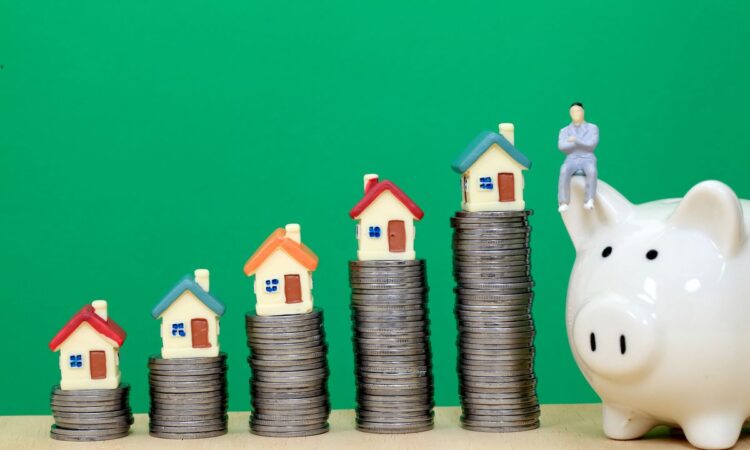
Annual house price growth remained at 2.7% in June as the property market appears to have paused in the build-up to the general election, official figures suggest.
The latest Office for National Statistics (ONS) House Price Index shows average UK property values rose 2.7% annually during June, the same level as the property market activity recorded a month before and the highest rate since March 2023.
Average prices were also relatively flat on a monthly basis, rising just 0.5% between May and June.
Sign up to Money Morning
Don’t miss the latest investment and personal finances news, market analysis, plus money-saving tips with our free twice-daily newsletter
Don’t miss the latest investment and personal finances news, market analysis, plus money-saving tips with our free twice-daily newsletter
This puts the average UK house price at £288,000, £8,000 higher than a year ago.
The data, based on property completions recorded with the Land Registry, typically has a time-lag of at least two months. It represents the period before the general election where many buyers and sellers will have paused to see who formed the next government.
Banks, brokers and estate agents have reported an increase in activity more recently, helped by falling inflation and the Bank of England’s interest rate cut earlier this month.
“We’re seeing a few positive signs that the property market is heating up this summer, with house prices rising in June,” says Nicky Stevenson, managing director at national estate agent group Fine & Country.
“Alongside improving personal finances, this is creating new opportunities for potential homebuyers – especially with inflation generally holding steady around the government’s 2% target.
“The Bank of England‘s recent base rate cut from 5.25% to 5% has sparked a wave of mortgage rate reductions across the banking sector. This competitive environment is particularly good news for consumers, especially first-time buyers who’ve been struggling to enter the market.”
What is happening with UK house prices?
Many analysts had expected house prices to fall this year.
That was the case in the first months of 2024 as sticky inflation and high interest rates reduced homebuyer budgets and contributed to a decline in property demand.
But the consumer prices index fell in May to reach 2% and interest rates have now been cut, lowering the cost of borrowing.
This has fed into house prices in recent months.
When split by type of purchaser, first-time buyer property prices rose 2.8% annually in June to £241,502.
Those moving up the ladder are paying £333,345, up 2.5% compared with June 2023.
On a regional basis, average house prices in the 12 months to June 2024 increased 2.4% in England to £305,000 and by 1.8% in Wales to £216,000.
Scottish prices rose 4.3% to £192,000, while values in Northern Ireland were up 6.4% on a quarterly basis to £185,000.
All English regions experienced annual house price growth in June, with Yorkshire and Humber leading the way with a 4.7% rise, followed by 4.2% in the North East.
London remains the most expensive region, with average prices at £523,134 but it registered the lowest annual growth rate at just 0.6%.
The only regions to experience monthly falls were the East Midlands and the South West, down 0.5% and 1% respectively.
More recent data from the Halifax and Nationwide house price indices suggests typical prices are continuing to rise.
For example, the latest Halifax House Price Index recorded annual growth of 2.3% in July, the highest level since the start of the year.
“The market, after three relatively flat months, is beginning to heat up—particularly during what is traditionally a busy summer period for property transactions,” says Holly Tomlinson, financial planner at Quilter.
“The recent decision by the Bank of England to cut its base rate from 5.25% to 5% is expected to further stimulate the market, although the immediate financial impact on homeowners, especially those with fixed-rate mortgages, may be limited.
“The psychological effect of this rate cut cannot be understated. It boosts buyer and seller confidence, potentially encouraging more people to enter the market. This renewed confidence could lead to a busier-than-expected autumn, as more buyers feel ready to commit and sellers decide that now is the right time to list their properties.”
Tom Bill, head of UK residential research at Knight Frank, suggests August may prove to be a turning point for the property market.
“The first rate cut in more than four years and lower-than-expected inflation numbers should boost demand this autumn and we expect average prices to rise by 3% in 2024,” he says.
Is now a good time to buy a property?
Lower house price growth and falling mortgage rates can make it a good time to buy a property.
Several lenders now boast sub-4% mortgage rates. Buyers need to act fast though as average mortgage shelf-life is at just 17 days, so the best deals may disappear fast.
There is also a risk as the cost of borrowing falls that demand grows, pushing house prices higher.
But Sarah Coles, head of personal finance for Hargreaves Lansdown, suggests mortgage rates are still relatively high by historical standards so a “massive influx of buyers” is unlikely.
“Given that expected rate cuts have already been priced in, they’re unlikely to move far in the immediate future,” she says.
“With house prices so high, it means plenty of potential buyers will have to bide their time in the hope that mortgage rates ease. If you’re in this position, it’s vital to do what you can to boost your deposit in the interim, whether that’s by increasing monthly savings or using a Lifetime ISA to give your savings a 25% boost from the government.”
